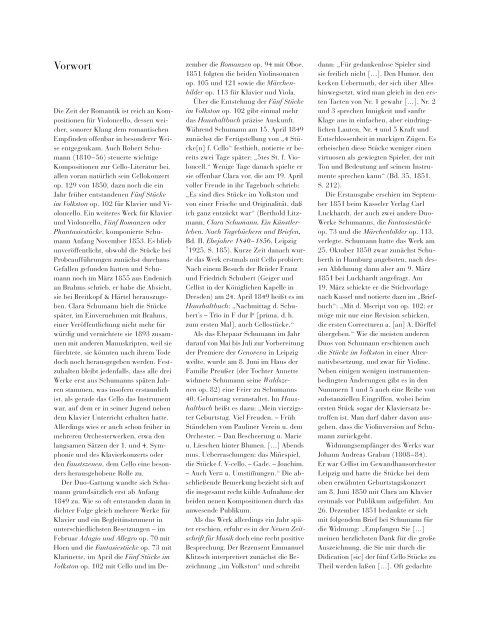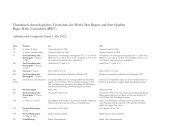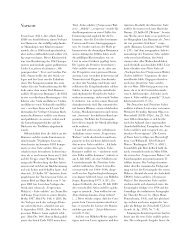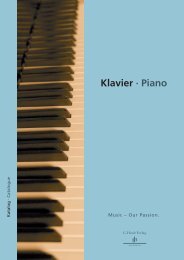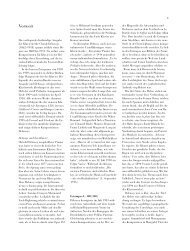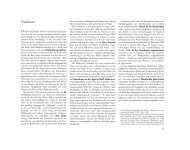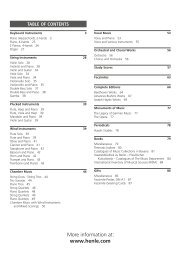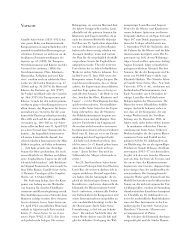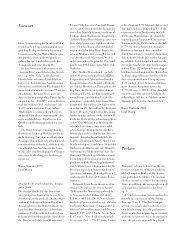Vorwort (PDF, 384 KB) - Henle Verlag
Vorwort (PDF, 384 KB) - Henle Verlag
Vorwort (PDF, 384 KB) - Henle Verlag
Create successful ePaper yourself
Turn your PDF publications into a flip-book with our unique Google optimized e-Paper software.
IV<br />
<strong>Vorwort</strong><br />
Die Zeit der Romantik ist reich an Kompositionen<br />
für Violoncello, dessen weicher,<br />
sonorer Klang dem romantischen<br />
Empfinden offenbar in besonderer Weise<br />
entgegenkam. Auch Robert Schumann<br />
(1810–56) steuerte wichtige<br />
Kompositionen zur Cello-Literatur bei,<br />
allen voran natürlich sein Cellokonzert<br />
op. 129 von 1850, dazu noch die ein<br />
Jahr früher entstandenen Fünf Stücke<br />
im Volkston op. 102 für Klavier und Violoncello.<br />
Ein weiteres Werk für Klavier<br />
und Violoncello, Fünf Romanzen oder<br />
Phantasiestücke, komponierte Schumann<br />
Anfang November 1853. Es blieb<br />
unveröffentlicht, obwohl die Stücke bei<br />
Probeaufführungen zunächst durchaus<br />
Gefallen gefunden hatten und Schumann<br />
noch im März 1855 aus Endenich<br />
an Brahms schrieb, er habe die Absicht,<br />
sie bei Breitkopf & Härtel herauszugeben.<br />
Clara Schumann hielt die Stücke<br />
später, im Einvernehmen mit Brahms,<br />
einer Veröffentlichung nicht mehr für<br />
würdig und vernichtete sie 1893 zusammen<br />
mit anderen Manuskripten, weil sie<br />
fürchtete, sie könnten nach ihrem Tode<br />
doch noch herausgegeben werden. Festzuhalten<br />
bleibt jedenfalls, dass alle drei<br />
Werke erst aus Schumanns späten Jahren<br />
stammen, was insofern erstaunlich<br />
ist, als gerade das Cello das Instrument<br />
war, auf dem er in seiner Jugend neben<br />
dem Klavier Unterricht erhalten hatte.<br />
Allerdings wies er auch schon früher in<br />
mehreren Orchesterwerken, etwa den<br />
langsamen Sätzen der 1. und 4. Symphonie<br />
und des Klavierkonzerts oder<br />
den Faustszenen, dem Cello eine besonders<br />
herausgehobene Rolle zu.<br />
Der Duo-Gattung wandte sich Schumann<br />
grundsätzlich erst ab Anfang<br />
1849 zu. Wie so oft entstanden dann in<br />
dichter Folge gleich mehrere Werke für<br />
Klavier und ein Begleitinstrument in<br />
unterschiedlichsten Besetzungen – im<br />
Februar Adagio und Allegro op. 70 mit<br />
Horn und die Fantasiestücke op. 73 mit<br />
Klarinette, im April die Fünf Stücke im<br />
Volkston op. 102 mit Cello und im Dezember<br />
die Romanzen op. 94 mit Oboe.<br />
1851 folgten die beiden Violinsonaten<br />
op. 105 und 121 sowie die Märchenbilder<br />
op. 113 für Klavier und Viola.<br />
Über die Entstehung der Fünf Stücke<br />
im Volkston op. 102 gibt einmal mehr<br />
das Haushaltbuch präzise Auskunft.<br />
Während Schumann am 15. April 1849<br />
zunächst die Fertigstellung von „4 Stücke[n]<br />
f. Cello“ festhielt, notierte er bereits<br />
zwei Tage später: „5tes St. f. Violoncell.“<br />
Wenige Tage danach spielte er<br />
sie offenbar Clara vor, die am 19. April<br />
voller Freude in ihr Tagebuch schrieb:<br />
„Es sind dies Stücke im Volkston und<br />
von einer Frische und Originalität, daß<br />
ich ganz entzückt war“ (Berthold Litzmann,<br />
Clara Schumann. Ein Künstlerleben.<br />
Nach Tagebüchern und Briefen,<br />
Bd. II, Ehejahre 1840–1856, Leipzig<br />
7 1925, S. 185). Kurze Zeit danach wurde<br />
das Werk erstmals mit Cello probiert:<br />
Nach einem Besuch der Brüder Franz<br />
und Friedrich Schubert (Geiger und<br />
Cellist in der Königlichen Kapelle in<br />
Dresden) am 24. April 1849 heißt es im<br />
Haushaltbuch: „Nachmittag d. Schubert’s<br />
– Trio in F dur I a [prima, d. h.<br />
zum ersten Mal], auch Cellostücke.“<br />
Als das Ehepaar Schumann im Jahr<br />
darauf von Mai bis Juli zur Vorbereitung<br />
der Premiere der Genoveva in Leipzig<br />
weilte, wurde am 8. Juni im Haus der<br />
Familie Preußer (der Tochter Annette<br />
widmete Schumann seine Waldszenen<br />
op. 82) eine Feier zu Schumanns<br />
40. Geburtstag veranstaltet. Im Haushaltbuch<br />
heißt es dazu: „Mein vierzigster<br />
Geburtstag. Viel Freuden. – Früh<br />
Ständchen vom Pauliner Verein u. dem<br />
Orchester. – Dan Bescheerung u. Marie<br />
u. Lieschen hinter Blumen. […] Abends<br />
mus. Ueberraschungen: das Miiespiel,<br />
die Stücke f. V-cello. – Gade. – Joachim.<br />
– Auch Ver= u. Umstihungen.“ Die abschließende<br />
Bemerkung bezieht sich auf<br />
die insgesamt recht kühle Aufnahme der<br />
beiden neuen Kompositionen durch das<br />
anwesende Publikum.<br />
Als das Werk allerdings ein Jahr später<br />
erschien, erfuhr es in der Neuen Zeitschrift<br />
für Musik doch eine recht positive<br />
Besprechung. Der Rezensent Emmanuel<br />
Klitzsch interpretiert zunächst die Bezeichnung<br />
„im Volkston“ und schreibt<br />
dann: „Für gedankenlose Spieler sind<br />
sie freilich nicht […]. Den Humor, den<br />
kecken Uebermuth, der sich über Alles<br />
hinwegsetzt, wird man gleich in den ersten<br />
Tacten von Nr. 1 gewahr […], Nr. 2<br />
und 3 sprechen Innigkeit und sanfte<br />
Klage aus in einfachen, aber eindringlichen<br />
Lauten, Nr. 4 und 5 Kraft und<br />
Entschlossenheit in markigen Zügen. Es<br />
erheischen diese Stücke weniger einen<br />
virtuosen als gewiegten Spieler, der mit<br />
Ton und Bedeutung auf seinem Instrumente<br />
sprechen kann“ (Bd. 35, 1851,<br />
S. 212).<br />
Die Erstausgabe erschien im September<br />
1851 beim Kasseler <strong>Verlag</strong> Carl<br />
Luckhardt, der auch zwei andere Duo-<br />
Werke Schumanns, die Fantasiestücke<br />
op. 73 und die Märchenbilder op. 113,<br />
verlegte. Schumann hatte das Werk am<br />
25. Oktober 1850 zwar zunächst Schuberth<br />
in Hamburg angeboten, nach dessen<br />
Ablehnung dann aber am 9. März<br />
1851 bei Luckhardt angefragt. Am<br />
19. März schickte er die Stichvorlage<br />
nach Kassel und notierte dazu im „Briefbuch“:<br />
„Mit d. Mscript von op. 102; er<br />
möge mir nur eine Revision schicken,<br />
die ersten Correcturen a. [an] A. Dörffel<br />
übergeben.“ Wie die meisten anderen<br />
Duos von Schumann erschienen auch<br />
die Stücke im Volkston in einer Alternativbesetzung,<br />
und zwar für Violine.<br />
Neben einigen wenigen instrumentenbedingten<br />
Änderungen gibt es in den<br />
Nummern 1 und 5 auch eine Reihe von<br />
substanziellen Eingriffen, wobei beim<br />
ersten Stück sogar der Klaviersatz betroffen<br />
ist. Man darf daher davon ausgehen,<br />
dass die Violinversion auf Schumann<br />
zurückgeht.<br />
Widmungsempfänger des Werks war<br />
Johann Andreas Grabau (1808–84).<br />
Er war Cellist im Gewandhausorchester<br />
Leipzig und hatte die Stücke bei dem<br />
oben erwähnten Geburtstagskonzert<br />
am 8. Juni 1850 mit Clara am Klavier<br />
erstmals vor Publikum aufgeführt. Am<br />
26. Dezember 1851 bedankte er sich<br />
mit folgendem Brief bei Schumann für<br />
die Widmung: „Empfangen Sie […]<br />
meinen herzlichsten Dank für die große<br />
Auszeichnung, die Sie mir durch die<br />
Didication [sic] der fünf Cello Stücke zu<br />
Theil werden laßen […]. Oft gedachte
ich Ihres Versprechens, daß Sie mir diese<br />
Stücke von Düsseldorf senden würden<br />
und konnte sie kaum vor Ungeduld<br />
erwarten. Und nun diese große unerwartete<br />
Freude! An vielen Orten in<br />
Leipzig so auch kürzlich in Grimma und<br />
Oschatz habe ich diese Stücke mit dem<br />
größten Beifall vorgeführt“ (zitiert nach<br />
Ute Bär, Robert Schumann und Johann<br />
Andreas Grabau, in: Schumann-Forschungen,<br />
Bd. 12, Robert Schumann,<br />
das Violoncello und die Cellisten seiner<br />
Zeit, hrsg. von Bernhard R. Appel<br />
und Matthias Wendt, Mainz etc. 2007,<br />
S. 152, 155).<br />
Ob die erwähnten Aufführungen vor<br />
privatem oder öffentlichem Publikum<br />
stattfanden, bleibt ungewiss. Bislang<br />
wurde immer ein Konzert mit Clara<br />
Schumann und dem berühmten Cellisten<br />
Friedrich Grützmacher am 6. Dezember<br />
1859 im Leipziger Gewandhaus<br />
als erste öffentliche Aufführung angesehen.<br />
Die Violinversion eines der fünf<br />
Stücke hatte Joseph Joachim bereits im<br />
August 1853 bei einem Konzert in Göttingen<br />
öffentlich gespielt.<br />
Genauere Angaben zu Autograph und<br />
Erstausgabe sowie zu den darin enthaltenen<br />
Lesarten finden sich in den Bemerkungen<br />
am Ende dieser Ausgabe. In<br />
den Quellen fehlende, aber musikalisch<br />
notwendige oder durch analoge Stellen<br />
begründete Zeichen sind in runde<br />
Klammern gesetzt.<br />
Allen in den Bemerkungen genannten<br />
Bibliotheken, die freundlicherweise<br />
Fotokopien der Quellen zur Verfügung<br />
gestellt haben, sei herzlich gedankt.<br />
Berlin, Frühjahr 2010<br />
Ernst Herttrich<br />
Preface<br />
The romantic era abounds in works for<br />
the violoncello, whose gentle, sonorous<br />
sound apparently struck a special cord<br />
in the romantic sensibility. Robert Schumann<br />
(1810–56) also contributed important<br />
works to the canon of cello literature,<br />
foremost among them his Cello<br />
Concerto op. 129 of 1850 and the Fünf<br />
Stücke im Volkston (Five Pieces in Folk<br />
Style) op. 102 for piano and cello, written<br />
one year earlier. The composer produced<br />
another work for piano and cello,<br />
Fünf Romanzen or Phantasiestücke, in<br />
early November 1853; but it remained<br />
unpublished, even though the pieces<br />
had met with great acclaim during various<br />
trial performances. As late as March<br />
1855, Schumann wrote to Brahms from<br />
Endenich that he intended to have them<br />
published by Breitkopf & Härtel. Later,<br />
Clara Schumann came to regard the<br />
pieces, with Brahms’s acquiescence, as<br />
unworthy of publication and destroyed<br />
them along with other manuscripts in<br />
1893, since she was afraid that they<br />
might still have been released after her<br />
death. It should be noted that all three<br />
works were written in Schumann’s later<br />
years, which is all the more remarkable<br />
as the cello was the very instrument<br />
which, along with the piano, he had<br />
learned to play in his youth. But he had<br />
already assigned a privileged role to the<br />
cello in some of his earlier orchestral<br />
works as well, such as the slow movements<br />
of the 1 st and 4 th Symphonies, the<br />
Piano Concerto or the Faustszenen.<br />
Schumann basically only began writing<br />
instrumental duets in early 1849. As<br />
was so often the case, he then produced<br />
in a close succession several works for<br />
piano and one accompanying instrument<br />
in a variety of scorings: in February<br />
the Adagio und Allegro op. 70 for<br />
horn and the Fantasiestücke op. 73 for<br />
clarinet, in April the Fünf Stücke im<br />
Volkston op. 102 for cello and in December<br />
the Romanzen op. 94 for oboe.<br />
This creative surge was followed in<br />
1851 by the two Violin Sonatas op. 105<br />
V<br />
and 121 and the Märchenbilder op. 113<br />
for piano and viola.<br />
Details concerning the origin of the<br />
Fünf Stücke im Volkston op. 102 can<br />
again be found in the Haushaltbuch. On<br />
15 April 1849 Schumann recorded the<br />
completion of “4 pieces for cello.” Two<br />
days later, we read: “5 th piece for violoncello.”<br />
He seems to have played them to<br />
Clara a few days later, for she joyfully<br />
noted in her diary on 19 April: “These<br />
are the pieces in folk style, which absolutely<br />
beguiled me with their freshness<br />
and originality” (Berthold Litzmann,<br />
Clara Schumann. Ein Künstlerleben.<br />
Nach Tagebüchern und Briefen, vol. II,<br />
Ehejahre 1840–1856, Leipzig, 7 1925,<br />
p. 185). A short while later, the work<br />
was given its first tryout with cello.<br />
After the brothers Franz and Friedrich<br />
Schubert (violinist and cellist in the<br />
Royal Chapel in Dresden) had paid him<br />
a visit on 24 April 1849, Schumann<br />
wrote in the Haushaltbuch: “This afternoon<br />
with the Schuberts – Trio in F major<br />
I a [prima, i. e. for the first time], cello<br />
pieces as well.”<br />
The following year, the Schumanns<br />
spent the months of May to July in Leipzig<br />
for the preparation of the premiere<br />
of Genoveva. On 8 June, a party celebrating<br />
Schumann’s 40 th birthday was<br />
held there in the home of the Preußer<br />
family (Schumann dedicated his Waldszenen<br />
op. 82 to the Preußer daughter<br />
Annette). In his Haushaltbuch, the<br />
composer wrote: “My 40 th birthday.<br />
Great joy. – In the morning a serenade<br />
by the Pauliner Verein and the orchestra.<br />
– Then gifts, with Marie and Lieschen<br />
behind flowers. […] Musical surprises<br />
in the evening: the Minnespiel,<br />
the pieces for cello. – Gade. – Joachim. –<br />
Also annoyance and bad temper.” The<br />
closing words referred to the very cool<br />
reception given to the two new works by<br />
the guests.<br />
Nevertheless, the work received a<br />
very positive review in the Neue Zeitschrift<br />
für Musik when it was published<br />
the following year. The critic Emmanuel<br />
Klitzsch began by interpreting the designation<br />
“in folk style” and continued:<br />
“They are certainly not intended for unreflecting<br />
players […]. The humour, the
VI<br />
boldness, and the audacity that take<br />
centre stage strike us immediately in the<br />
first measures of no. 1 […]; nos. 2 and 3<br />
express inwardness and gentle lament in<br />
simple but urgent tones; nos. 4 and 5<br />
put on a striking show of power and<br />
forcefulness. The pieces do not require a<br />
virtuoso as much as a savvy performer<br />
who can make his instrument speak<br />
with sounds and significance” (vol. 35,<br />
1851, p. 212).<br />
The first edition was published in<br />
September 1851 by Carl Luckhardt of<br />
Kassel, who also published two other<br />
duets of Schumann, the Fantasiestücke<br />
op. 73 and the Märchenbilder op. 113.<br />
Schumann had initially offered the work<br />
to Schuberth in Hamburg on 25 October<br />
1850; after Schuberth turned it down,<br />
the composer addressed an inquiry<br />
to Luckhardt on 9 March 1851. On<br />
19 March he sent the engraver’s copy<br />
to Kassel and noted in his “Briefbuch”<br />
(letter book): “Along with the manuscript<br />
of op. 102; he is to send me solely<br />
the revised version, the first proofs<br />
should go to A. Dörffel.” Like most of<br />
Schumann’s other duets, the Fünf Stücke<br />
im Volkston were also published in<br />
an alternative version namely for violin.<br />
Besides a few changes resulting from the<br />
use of a different instrument, there are<br />
also a number of substantial interventions<br />
in the musical text of numbers 1<br />
and 5 as well, which in no. 1 also affect<br />
the piano part. It is thus safe to assume<br />
that the violin version was prepared by<br />
Schumann himself.<br />
The work was dedicated to Johann<br />
Andreas Grabau (1808–84), a cellist in<br />
Leipzig’s Gewandhaus Orchestra. With<br />
Clara at the piano, he had played the<br />
pieces for the first time in front of an<br />
audience at the above-mentioned birthday<br />
concert of 8 June 1850. On 26 December<br />
1851 he wrote the composer to<br />
thank him for the dedication: “Please<br />
accept my warmest thanks for the great<br />
honour you have shown me by dedicating<br />
the five cello pieces to me […]. I often<br />
remembered your promise to send<br />
me these pieces from Düsseldorf, and<br />
was so impatient to receive them. And<br />
now this tremendous, unexpected joy!<br />
I have played them to the greatest acclaim<br />
at many venues in Leipzig and,<br />
recently, in Grimma and Oschatz as<br />
well” (as cited in Ute Bär, Robert Schumann<br />
und Johann Andreas Grabau, in:<br />
Schumann-Forschungen, vol. 12, Robert<br />
Schumann, das Violoncello und die<br />
Cellisten seiner Zeit, ed. by Bernhard<br />
R. Appel and Matthias Wendt, Mainz<br />
etc., 2007, pp. 152, 155).<br />
It is unclear whether these performances<br />
were private or public. Traditionally,<br />
music historians have always<br />
considered the recital given by Clara<br />
Schumann and the celebrated cellist<br />
Friedrich Grützmacher at the Leipzig<br />
Gewandhaus on 6 December 1859 as<br />
the first public performance. Joseph<br />
Joachim had already played in public<br />
the violin version of one of the five pieces<br />
in a recital in Göttingen in August<br />
1853.<br />
Further information concerning the<br />
autograph and first edition, as well as<br />
the readings contained therein, can be<br />
found in the Comments at the end of this<br />
volume. Signs and markings missing in<br />
the sources but musically necessary or<br />
legitimated by analogous passages have<br />
been placed in parentheses.<br />
We wish to extend our cordial thanks to<br />
all the libraries mentioned in the Comments<br />
for kindly putting photocopies of<br />
the sources at our disposal.<br />
Berlin, spring 2010<br />
Ernst Herttrich<br />
Préface<br />
L’époque romantique abonde en répertoire<br />
pour le violoncelle, instrument<br />
dont il semble que le timbre doux et sonore<br />
à la fois correspondait tout particulièrement<br />
à la sensibilité romantique.<br />
Robert Schumann (1810–56) apporta<br />
lui aussi d’importantes contributions à<br />
la littérature pour cet instrument, grâce<br />
notamment à son Concerto pour violoncelle<br />
op. 129 de 1850, ainsi qu’aux Fünf<br />
Stücke im Volkston op. 102 (Cinq pièces<br />
dans le ton populaire) pour piano et<br />
violoncelle composées un an plus tôt.<br />
Début novembre 1853, il écrivit également<br />
une autre œuvre pour piano et<br />
violoncelle, Fünf Romanzen ou Phantasiestücke.<br />
Bien qu’elles rencontrèrent<br />
un certain succès lors d’exécutions en<br />
avant-première, ces pièces ne furent pas<br />
publiées, alors même que Schumann<br />
écrivit à Brahms en mars 1855 depuis<br />
Endenich qu’il avait l’intention de les<br />
faire éditer chez Breitkopf & Härtel. Par<br />
la suite, en accord avec Brahms, Clara<br />
Schumann ne les jugea finalement plus<br />
dignes de publication et les détruisit en<br />
1893, en même temps que d’autres manuscrits<br />
dont elle craignait qu’ils puissent<br />
être publiés malgré tout après sa<br />
mort. Notons en tout cas que ces trois<br />
œuvres datent seulement des dernières<br />
années de Schumann, ce qui est surprenant<br />
dans la mesure où le violoncelle<br />
était justement l’instrument dont il avait<br />
appris à jouer au cours de sa jeunesse,<br />
parallèlement au piano. Toutefois, il<br />
attribua déjà auparavant au violoncelle<br />
une place de choix dans plusieurs de ses<br />
œuvres orchestrales, notamment dans<br />
les mouvements lents de la 1 re et de la<br />
4 e symphonies ainsi que dans celui du<br />
Concerto pour piano ou dans les Faustszenen.<br />
Schumann ne se consacra réellement<br />
au genre du duo qu’à partir du début de<br />
1849. Comme souvent dans son œuvre,<br />
il s’ensuivit aussitôt en série rapprochée<br />
la composition de plusieurs pièces consacrées<br />
au piano et à un autre instrument,<br />
dans les formations les plus variées<br />
– en février l’Adagio et Allegro<br />
op. 70 avec cor et les Fantasiestücke<br />
op. 73 avec clarinette, en avril les Fünf<br />
Stücke im Volkston op. 102 avec violoncelle,<br />
et en décembre les Romanzen<br />
op. 94 avec hautbois. En 1851, les deux<br />
Sonates pour violon op. 105 et 121<br />
suivirent, ainsi que les Märchenbilder<br />
op. 113 pour piano et alto.<br />
Son Haushaltbuch livre une fois de<br />
plus des indications précises sur la genèse<br />
des Fünf Stücke im Volkston op. 102.<br />
Alors que le 15 avril 1849 Schumann<br />
y consignait d’abord l’achèvement de
VII<br />
«4 pièces pour violoncelle», il nota à<br />
peine deux jours plus tard: «5 e pièce<br />
pour violoncelle.» Il joua apparemment<br />
ces pièces quelques jours plus tard à<br />
Clara, car celle-ci, transportée de joie,<br />
écrivit le 19 avril dans son journal: «Ce<br />
sont des pièces dans le style populaire,<br />
d’une telle fraîcheur et d’une telle originalité<br />
que j’en ai été ravie» (Berthold<br />
Litzmann, Clara Schumann. Ein Künstlerleben.<br />
Nach Tagebüchern und Briefen,<br />
vol. II, Ehejahre 1840–1856, Leipzig,<br />
7 1925, p. 185). Peu de temps après,<br />
l’œuvre fut jouée pour la première fois<br />
avec violoncelle: le 24 avril 1849, après<br />
une visite des frères Franz et Friedrich<br />
Schubert (respectivement violoniste<br />
et violoncelliste à la chapelle royale de<br />
Dresde), Schumann relève dans son<br />
journal: «Après-midi les Schubert – Trio<br />
en Fa majeur I a [prima, c.-à-d. pour la<br />
première fois], aussi pièces pour violoncelle.»<br />
Alors que le couple Schumann séjournait<br />
à Leipzig de mai à juillet l’année<br />
suivante, dans le cadre de la préparation<br />
de la première de Genoveva, une fête fut<br />
organisée à l’occasion du 40 e anniversaire<br />
de Schumann le 8 juin au domicile<br />
de la famille Preußer (Schumann a dédié<br />
ses Waldszenen op. 82 à leur fille<br />
Annette). Le compositeur rapporte cet<br />
événement de la manière suivante dans<br />
son Haushaltbuch: «Mon quarantième<br />
anniversaire. Beaucoup de joies. – Aubade<br />
matinale du Pauliner Verein et de<br />
l’orchestre. – Après, distribution des cadeaux<br />
et Marie et Lieschen derrière des<br />
fleurs. […] Le soir, surprises musicales:<br />
le Minnespiel, les pièces pour violoncelle.<br />
– Gade. – Joachim. – Aussi contrariété<br />
et mauvaise humeur.» La dernière remarque<br />
fait référence à l’accueil plutôt<br />
froid réservé aux deux nouvelles compositions<br />
par le public présent.<br />
Lorsque l’œuvre parut effectivement<br />
l’année suivante, elle fit pourtant l’objet<br />
d’un compte rendu plutôt positif dans la<br />
Neue Zeitschrift für Musik. Le critique<br />
Emmanuel Klitzsch explique d’abord la<br />
caractérisation «im Volkston» et écrit<br />
ensuite: «Elles [les pièces] ne conviennent<br />
certainement pas à des interprètes<br />
superficiels […]. Dès les premières mesures<br />
du n o 1, on remarque l’humour,<br />
l’impertinente exubérance planant sur<br />
l’ensemble […], les n os 2 et 3 expriment<br />
l’intériorité et une douce plainte par des<br />
sonorités simples mais pénétrantes, les<br />
n os 4 et 5 la force et la détermination par<br />
des traits vigoureux. Ces morceaux réclament<br />
moins un virtuose qu’un interprète<br />
capable qui fait parler son instrument<br />
de façon sonore et significative»<br />
(vol. 35, 1851, p. 212).<br />
La première édition parut en septembre<br />
1851 chez l’éditeur Carl Luckhardt<br />
de Kassel qui édita également deux<br />
autres œuvres en duo de Schumann, les<br />
Fantasiestücke op. 73 et les Märchenbilder<br />
op. 113. Le 25 octobre 1850,<br />
Schumann avait d’abord proposé son<br />
œuvre à l’éditeur Schuberth de Hambourg<br />
puis, après le refus de ce dernier,<br />
à Luckhardt le 9 mars 1851. Le<br />
19 mars, il envoyait à Kassel la copie<br />
à graver et notait à ce propos dans<br />
son «Briefbuch» (registre de courrier):<br />
«Avec le manuscrit de l’op. 102; à me<br />
renvoyer seulement une révision, remettre<br />
les premières corrections à A. Dörffel.»<br />
Comme la plupart des autres duos<br />
de Schumann, les Stücke im Volkston<br />
parurent également dans une autre formation,<br />
en l’occurrence pour piano et<br />
violon. Outre quelques rares modifications<br />
exigées par l’instrument, les numéros<br />
1 et 5 ont fait l’objet de toute une série<br />
de retouches substantielles, touchant<br />
même la partie de piano dans le premier<br />
morceau. On peut en déduire que la version<br />
pour violon remonte également à<br />
Schumann.<br />
Les Stücke im Volkston sont dédiées à<br />
Johann Andreas Grabau (1808–84).<br />
Violoncelliste à l’orchestre du Gewandhaus<br />
de Leipzig, ce dernier avait été<br />
l’interprète de ces pièces, avec Clara au<br />
piano, lorsqu’elles furent présentées<br />
pour la première fois au public à l’occasion<br />
du concert d’anniversaire évoqué<br />
plus haut. Le 26 décembre 1851, il remercia<br />
Schumann de la dédicace au<br />
moyen de la lettre suivante: «Veuillez<br />
recevoir […] mes plus chaleureux remerciements<br />
pour le grand honneur que<br />
vous me faites par la dédicace des cinq<br />
pièces pour violoncelle […]. J’ai souvent<br />
repensé à votre promesse de m’envoyer<br />
ces pièces depuis Düsseldorf et je pouvais<br />
à peine juguler mon impatience. Et<br />
maintenant cette grande joie inattendue!<br />
J’ai joué ces morceaux avec grand<br />
succès en de nombreux endroits à Leipzig<br />
et récemment aussi à Grimma et<br />
Oschatz» (cité d’après Ute Bär, Robert<br />
Schumann und Johann Andreas Grabau,<br />
dans: Schumann-Forschungen,<br />
vol. 12, Robert Schumann, das Violoncello<br />
und die Cellisten seiner Zeit, éd.<br />
par Bernhard R. Appel et Matthias<br />
Wendt, Mayence etc., 2007, pp. 152,<br />
155).<br />
Il est impossible de déterminer si les<br />
représentations dont il est fait mention<br />
eurent lieu dans un cadre privé ou public.<br />
Jusqu’à présent le concert du 6 décembre<br />
1859 au Gewandhaus de Leipzig<br />
avec Clara Schumann et le célèbre<br />
violoncelliste Friedrich Grützmacher a<br />
toujours été considéré comme la première<br />
représentation publique de cette œuvre.<br />
La version pour violon de l’une des<br />
cinq pièces avait déjà été jouée en public<br />
par Joseph Joachim en août 1853, lors<br />
d’un concert à Göttingen.<br />
Des indications plus précises à propos<br />
du manuscrit autographe et de la première<br />
édition se trouvent dans les Bemerkungen<br />
ou Comments à la fin de cette<br />
édition. Les signes manquant dans les<br />
sources, mais nécessaires musicalement<br />
ou justifiés par des passages analogues,<br />
sont mis entre parenthèses.<br />
Nous remercions chaleureusement toutes<br />
les bibliothèques citées dans les<br />
Bemerkungen ou Comments qui ont<br />
aimablement mis des photocopies des<br />
sources à notre disposition.<br />
Berlin, printemps 2010<br />
Ernst Herttrich


